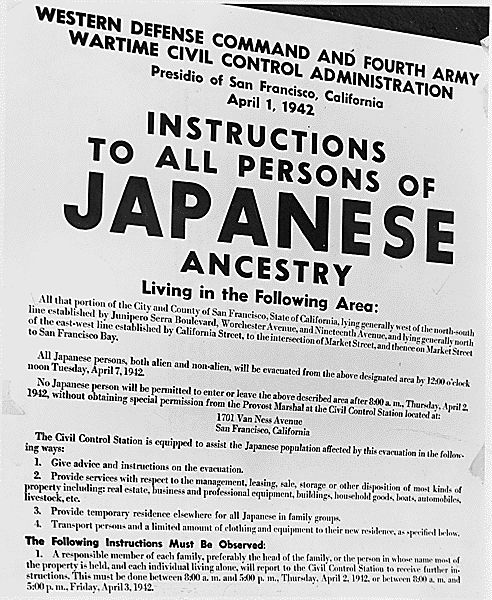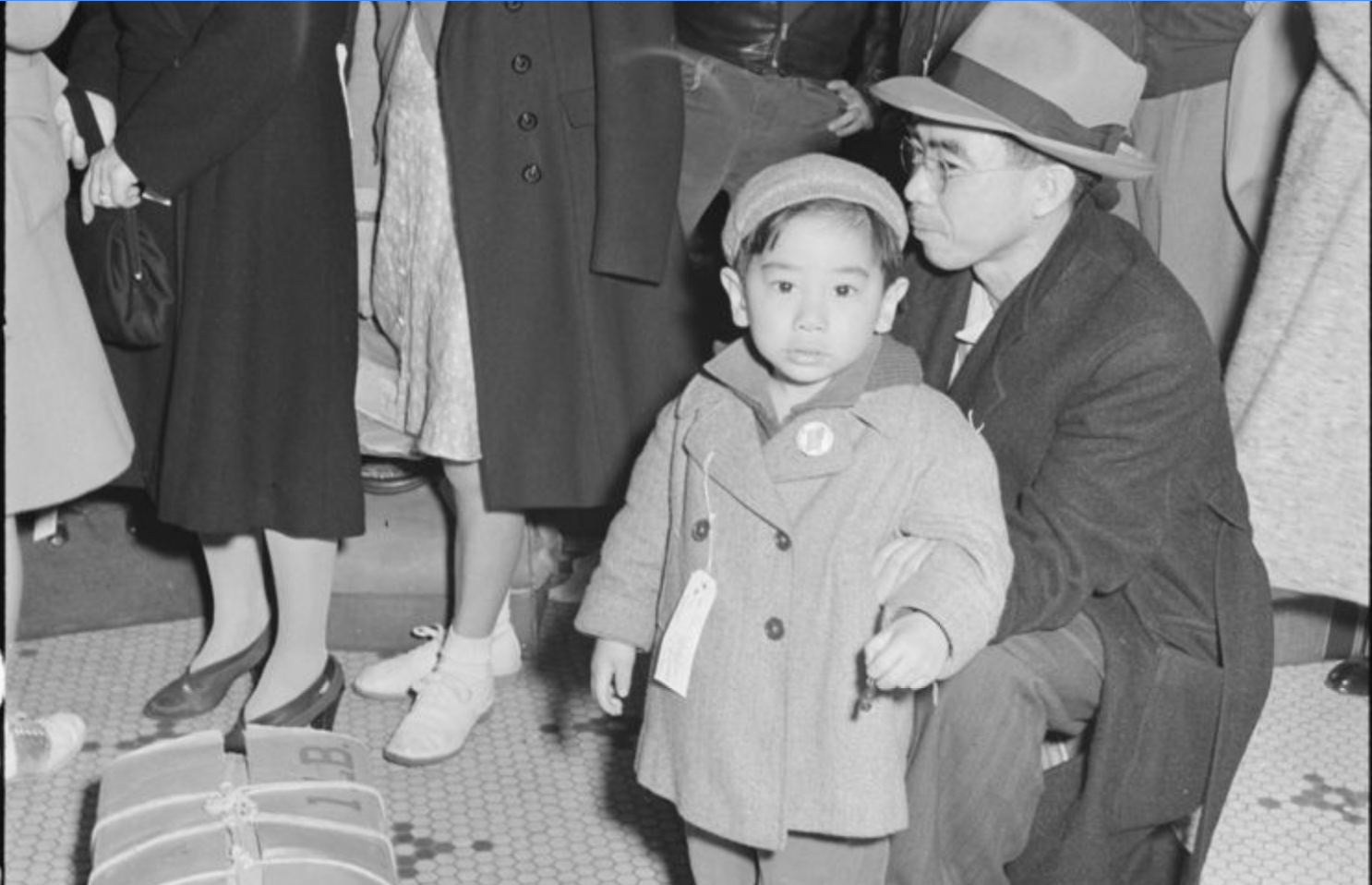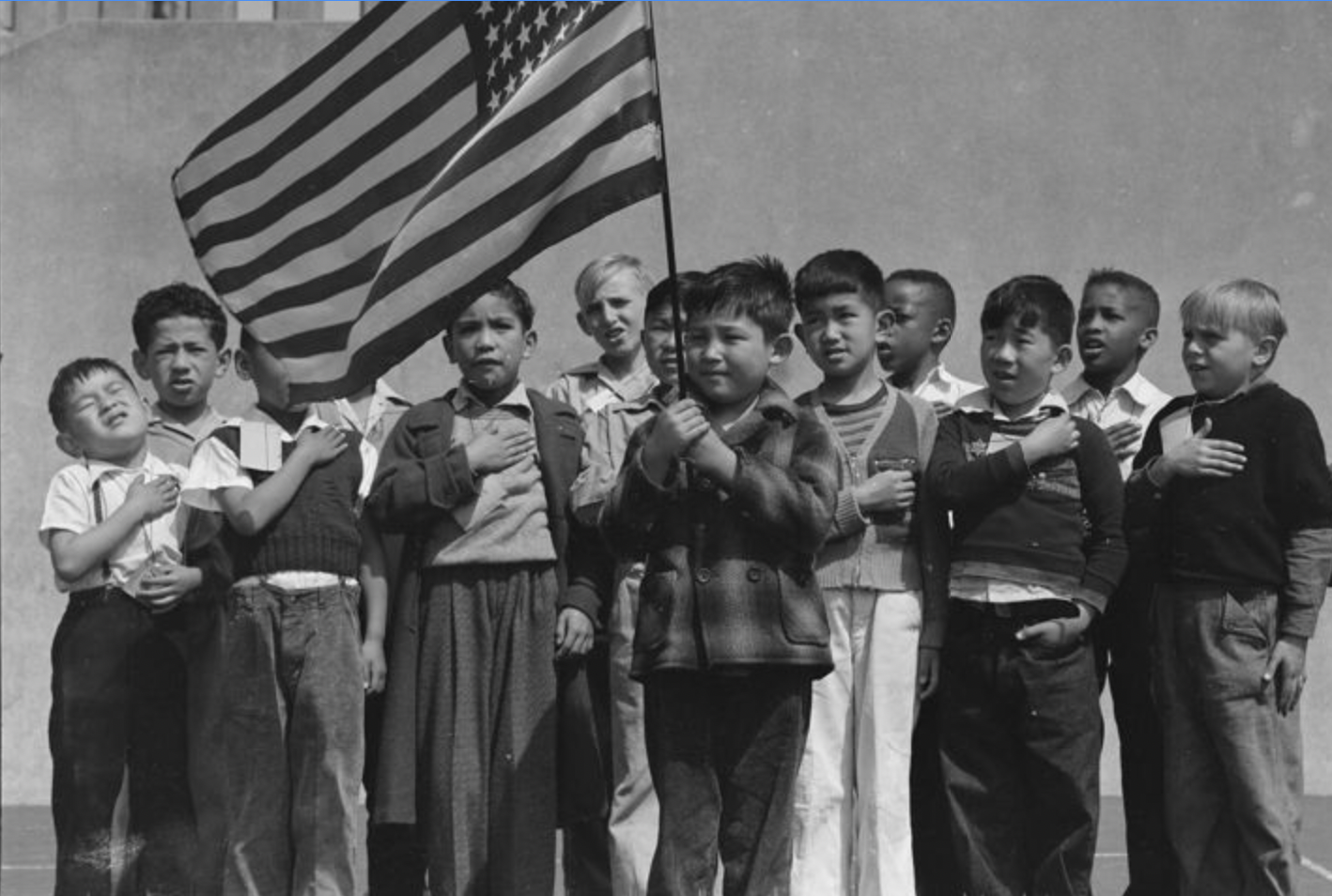2.1.2 - Citizenship and Japanese American Incarceration
The Asian American Education Project
Grade: 7-10Subject:
U.S. History, Social Studies
Number of Lessons/Activities: 4
On February 19, 1942, President Franklin D. Roosevelt issued Executive Order No. 9066, forcing over 120,000 Japanese Americans into incarceration camps, where they faced mistreatment and had their loyalty to the United States questioned. In response to this injustice and violation of their constitutional rights, Japanese Americans resisted and sought reparations and apologies from the U.S. government. In this lesson, students will use a media literacy analysis to examine how the constitutional rights of Japanese Americans, including those who were U.S. citizens, were violated during World War II.
Are there any circumstances in which it is acceptable for a democracy such as the United States to change/bend its governing principles of freedom and equality under the U.S. Constitution?
Students will:
- Use a media literacy analysis to examine how the constitutional rights of Japanese Americans, including those who were U.S. citizens, were violated during World War II.
Citizenship and Japanese American Incarceration Essay:
Background:
The idea of the “Yellow Peril” (the fear of Asians invading and taking over) arose in the late 19th century and painted Asians as unassimilable, untrustworthy, and, ultimately, enemies. Japanese people in the United States were targeted increasingly after Chinese exclusion in 1882. As Japan’s military power grew overseas,
white supremacist groups lobbied to stop all immigration from Japan, with a number of western states passing alien land laws to forbid Japanese immigrants from owning or leasing farmland. The height of the “Yellow Peril” fear happened immediately after Japan's attack on Pearl Harbor on December 7, 1941.
The attack by Japan came without a declaration of war or formal warning. President Franklin D. Roosevelt called the attack “a date which will live in infamy.” Japan later declared war on the United States that day, and Congress declared war on Japan the following day. A few days later, Germany and Italy each declared war on the United States, and the U.S. declared war in response, thus formally entering World War II. Japan’s attack on Pearl Harbor only increased the existing anti-Japanese racism in the country. Newspapers, radio, and movies stereotyped Japanese Americans as untrustworthy and depicted them as spies, justifying the harsh treatment and discrimination against them. Throughout the entire war, no Japanese American was ever convicted of spying for Japan.
Essay:
On February 19, 1942, two months after Pearl Harbor in Hawai
ʻi was bombed by Japan, President Franklin D. Roosevelt issued
Executive Order No. 9066. This order forcibly incarcerated more than 120,000 Japanese Americans (79,000 of whom were U.S. citizens). Anyone with at least 1/16th of Japanese blood was incarcerated, including infants. Since the United States was at war with Japan during World War II, Japanese Americans were seen as “the enemy.”
Japanese Americans who lived on the West Coast were forcibly relocated and held in ten different
incarceration camps that were distributed across the U.S., west of the Mississippi. No charges were ever brought against them, and there were no hearings held.
The U.S. government allowed Japanese Americans to bring only what they could carry to the camps, and were given only one week to dispose of the rest of their personal belongings. Many lost their jobs, homes, and property. They did not know where they were going or how long they would be incarcerated.
Japanese Americans also faced mistreatment inside the camps. Many families were separated, living and raising children in poor and harsh conditions. They lacked adequate food to eat, milk for babies, and coal for heat. Uprisings broke out because of these deplorable conditions. Several incarcerees were shot and killed by military police, and the suicide rate inside the camps was high.
Incarcerated Japanese Americans were also forced to answer a questionnaire regarding their loyalty to the United States. If they responded “no” to the loyalty questionnaire, they were transferred to the Tule Lake incarceration camp where they faced even harsher conditions.
Japanese Americans resisted and fought for their constitutional rights during this time. In 1942, Fred Toyosaburo Korematsu defied Executive Order 9066 and went into hiding instead of going to an incarceration camp. Korematsu was arrested in May 1942 and convicted of defying the government order. But, in 1944, he fought his case at the Supreme Court, arguing that his
Fifth Amendment rights were being violated by incarceration. The Court however ruled against him and deemed it a military necessity that all Japanese be moved to prison camps on the West Coast under a justified measure to protect national security.
Later, Japanese Americans, especially the post-war generation, continued to resist, fighting for
reparations and an apology for the grave injustice they had endured from their own country. In 1983, a federal report by the Commission on Wartime Relocation and Internment of Civilians found that the broad causes of Japanese American incarceration were racial prejudice, war hysteria, and a failure of political leadership. That same year, Fred Korematsu’s case was overturned. As a result of tireless campaigning by the Japanese American community, the U.S. government finally issued a formal apology for violating the
civil liberties of Japanese Americans guaranteed by the Constitution and provided reparations to living survivors of the camps through the Civil Liberties Act of 1988.
The Japanese American Incarceration during World War II is a stark reminder that a racial minority’s civil liberties can be easily violated in the name of national security. It provides a cautionary tale of the need for vigilance in safeguarding the civil liberties of all people, particularly racial minorities, and others targeted and blamed for problems by the dominant group.
Bibiliography:
Nagata, D. K., Kim, J., & Wu, K.. “The Japanese American wartime incarceration: Examining the scope of racial Trauma.”
American Psychologist, vol. 74, no.1, 2019, pp. 36–48.,
https://doi.org/10.1037/amp0000303.
- Civil Liberties: fundamental rights and freedoms protected by the Constitution
- Executive Order: a signed, written, and published directive from the U.S. President
- Fifth Amendment: a citizen’s right that guarantees a person cannot be compelled by the government to provide incriminating information against themselves
- Incarceration: the placement of people in a prison for a lengthy period of time
- Loyalty: faith to a country, ideas or person
- Reparations: compensation to make up for a past wrong
- White Supremacist: a person who believes that white people constitute a superior race and should therefore dominate society, typically to the exclusion or detriment of other racial and ethnic groups
- What historical events, national sentiment, and lack of political leadership led to Executive Order 9066?
- What is the impact of the Perpetual Foreigner Stereotype on Japanese American incarceration?
- How did the U.S. government justify the incarceration of Japanese Americans?
Photo taken by Dorothea Lange of barrack homes at Manzanar Relocation Center, an incarceration camp where Japanese American families were forced to live.
Credit: Department of the Interior via National Archives (Public Domain)
Activity 1: Understanding Incarceration
- Read aloud Tetsuzo Hirasaki’s Letter (http://smithsonianeducation.org/educators/lesson_plans/japanese_internment/letter_d.html). Have students deduce the historical context by recording noticings and wonderings and asking the following prompts:
- What did you learn from Hirasaki’s letter? What are your noticings?
- What questions or wonderings do you have? What information are you missing? What confuses you?
- Explain that during World War II, Japanese Americans were forcefully removed from their homes and sent to incarceration camps. Share that Tetzuzo Hirasaki wrote that letter from an incarceration camp.
- Facilitate a discussion using the following prompt: When you hear the word “incarceration” what does it mean to you?
- NOTE TO TEACHER: For many years, the Japanese American Incarceration experience was called “internment.” Japanese American activists prefer incarceration as it is a better descriptor of the experience. Learn more from the Japanese American Citizens League’s “The Power of Words” resource (https://jacl.org/power-of-words). Give students two minutes to do a quickwrite about their thoughts about the video.

This exclusion order instructing all people of Japanese ancestry to evacuate San Francisco was posted on April 1, 1942.
Credit: Franklin D. Roosevelt Library via National Archives (Public Domain)
Activity 2: Japanese American Incarceration
- Have students read the essay on Japanese American Exclusion (see worksheet entitled, “Essay: Citizenship and Japanese American Incarceration.”) Facilitate a discussion about the essay using the Discussion Questions.
- NOTE TO TEACHER: If you have limited classroom time, have students complete the reading as a homework assignment the night before you implement this lesson.
- NOTE TO TEACHER: If students need more support understanding the Perpetual Foreigner Stereotype, review the first lesson in the Citizenship unit, “Introducing the Theme of Citizenship in Asian Pacific Islander Desi American (APIDA) History” and/or implement The Asian American Education Project’s lesson entitled, “Perpetual Foreigner - Systemic Racism Against Asian Americans”: https://asianamericanedu.org/perpetualforeigner.html.
- NOTE TO TEACHER: If students need more support in understanding the Japanese American Incarceration experience, have them read the article entitled, “Japanese American Incarceration: Seeking Truth, Healing, and Reconciliation Through Art”: https://www.socialstudies.org/social-education/86/2/japanese-american-incarceration-seeking-truth-healing-and-reconciliation.
- NOTE TO TEACHER: If time permits and if students need more support, watch the video in and/or implement The Asian American Education Project’s lesson entitled, “Japanese Americans and Aleuts Incarceration Constitutional Violations”: https://asianamericanedu.org/japanese-americans-aleuts-incarceration-constitutional-violations.html.
- Inform students that Japanese American Incarceration violated the rights of U.S. citizens. Distribute the worksheet entitled, “Violation of Japanese American Rights Worksheet.” Explain to students that the worksheet lists the specific ways in which Japanese Americans’ rights were violated through their wartime incarceration. Have students complete the worksheet independently or in small groups:
- Instruct students to complete the first part in which they will research and summarize each Amendment. (Make sure students have access to the Internet.)
- Instruct students to complete the second part in which they will match the Amendment to the corresponding violation.
- Review the answers.
- NOTE TO TEACHERS: Instead of having students complete the worksheet, you may give them the Answer Key to use as a resource.
- Facilitate a discussion about the worksheet using these prompts:
- How do the examples on the worksheet violate the Constitution?
- Did the U.S. government’s reason for incarceration justify the violations against its own citizens? (Was it worth it?)
- What is the danger of such violations?
- How and why did/do we allow such violations to occur?
- Inform students that the U.S. government controlled the messaging around Japanese American Incarceration. Share the following:
- “The U.S. government hired six photographers to document the incarceration. Dorothea Lange was the first one hired. She mainly documented the forced removal process. The U.S. government wanted Lange to show how orderly and necessary these removals were; but instead her photographs showed the humanity of the incarcerated Japanese Americans. As such, the U.S. government did not publicly show her photographs. On the other hand, Ansel Adams, who depicted camp life as a place of joy, was given permission to enter and photograph one of the camps at Manzanar. The government showed Adams’ photographs to the public.”
- Facilitate a discussion about the above statement using these prompts:
- Who gets to tell or control the story?
- Why would the U.S. government want to control who gets to take photographs and who doesn’t?
- Why would the U.S. government want to control what is seen and what isn’t?
- How does this compromise the First Amendment?

Photo taken by Dorothea Lange of a family at the Wartime Civil Control Administration station in San Francisco, CA.
Credit: Department of the Interior via National Archives (Public Domain)
Activity 3: Media Literacy
- Explain to students how the media plays a significant role in policy-making. Ask students to share some contemporary examples. Explain that media literacy or the ability to critically analyze media is essential if we are to be an informed citizen and want to protect our civil rights/liberties.
- NOTE TO TEACHER: An example of how the media influences policy is the U.S. involvement in the Syrian crisis. Years of tragic imagery and reporting emerging from the conflict kept Syria on the agenda, creating constant pressure from the media to “do something.” Interviews with senior U.S. policymakers, mainly from the Obama Administration, claimed that this led to some policy responses that President Barack Obama did not fully support.
- Explain to students the following: The key concepts of media literacy are: (1) Media are constructions; (2) Media meanings are negotiated by audiences; (3) Media have commercial, social, and political implications; and (4) Media have unique aesthetic forms.
- Explain how photographs are primary sources as they present a visual record of a moment in time.
- Show students this photograph taken by Dorothea Lange: https://www.loc.gov/pictures/item/2021653154/resource/. Model how to complete each section of the worksheet entitled, “Incarceration: Media Literacy Analysis” (See Answer Key)
- Authorship: Who constructed the message? What is their position/background? Is the author an insider or outsider?
- Visible Content: What do you see in the message? What is obvious?
- Embedded Content: What message is embedded? What is implied but not clearly stated or obvious?
- Hidden Content: What message is not seen? What information is missing? What does the author not want you to see or know?
- Format: What is the genre/format? Why does this form matter? What specific element did the author use for effects and why?
- Purpose: Why is this message being conveyed? Is the goal to explain, persuade, etc.?
- Audience(s): Who is meant to receive or interpret this message? Why was this audience targeted?
- Show students this photograph taken by Ansel Adams: https://www.loc.gov/pictures/item/2002695963/. Have students complete the worksheet entitled, “Incarceration: Media Literacy Analysis.” Review student responses (see Answer Key).
- NOTE TO TEACHER: If time permits, have students analyze a photograph by Toyo Miyatake and compare his work to that of Dorothea Lange and Ansel Adams.
- Facilitate a discussion about the photographs using these prompts:
- What do the photographs say about the Japanese American Incarceration experience? How are the photographs similar? How are they different? What accounts for the differences?
- How are these photographs constructed? What messages are we supposed to gain from the photographs?
- How do you as the audience interact with the photographs? What do the photographs mean to you?
- What are the purposes (i.e., social and/or political implications) of the photographs?
- How would you describe the look and style of the photographs? What are the effects of the look and style on the message?
- Why is it important to study the attributes of a constructed message?
- NOTE TO TEACHER: If students have the necessary background knowledge, facilitate a discussion about the role of media in a democracy.
- Assign students the following task for homework as an assessment: “In one page, respond to this question: Are there any circumstances in which it is okay for a democracy such as the United States to change/bend its governing principles of freedom and equality under the U.S. Constitution?”

Photo taken by Dorothea Lange of children at Raphael Weill Public School in San Francisco, CA with an American flag. Days after this photo was taken, Japanese children were taken out of schools and placed in War Relocation Authority centers to go to school.
Credit: Department of the Interior via National Archives (Public Domain)
Activity 4: Drawing Parallels between Japanese American Incarceration and Present Day
- Facilitate a class discussion using these prompts:
- How is propaganda and/or media used to justify political positions and/or actions?
- Why is it important as a citizen to question and to be vigilant about our constitutional rights?
- Why are constitutional rights and freedoms important, and how do we ensure that they are protected for everyone?
- Are there present-day instances and examples of government-enabled violations of constitutional rights and freedom?
- Explain to students that Tom Ikeda, a Japanese American, is the Executive Director of Densho, a nonprofit organization dedicated to documenting the testimonies of Japanese Americans who were unjustly incarcerated during WWII.
- Read this quote from Tom Ikeda, who compared Japanese American Incarceration to today’s policies around immigrant detention: “We can today be the allies that the Japanese Americans didn’t have.” Ask students to discuss what Ikeda means and why it’s important to be allies and to stand up against violations of constitutional rights.
- Tell students that by drawing parallels between their own history of unjust incarceration and today’s immigrants who are currently experiencing similar unjust detention and incarceration, Japanese Americans across the country continue to recognize, teach about, and honor their history.
- NOTE TO TEACHER: If time permits, facilitate a discussion about the importance of cross-cultural solidarity.
- If you are teaching this lesson as part of the Citizenship unit: Inform students they will be learning more about immigration policies.



